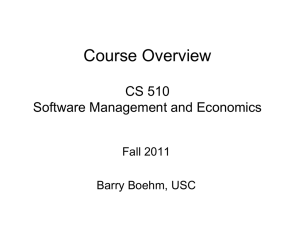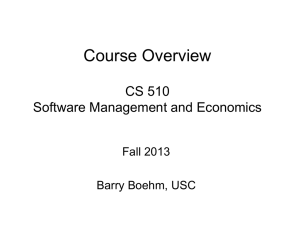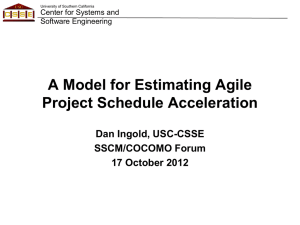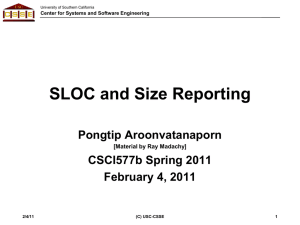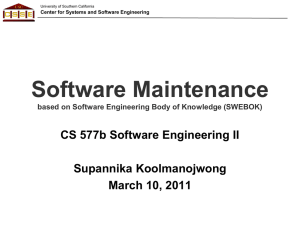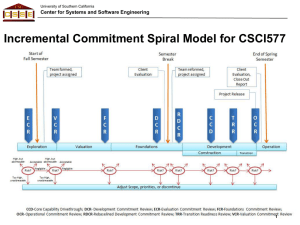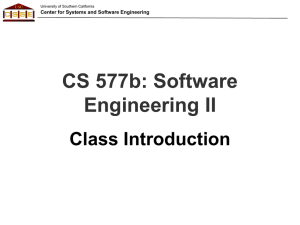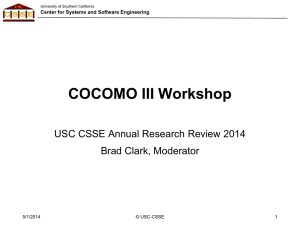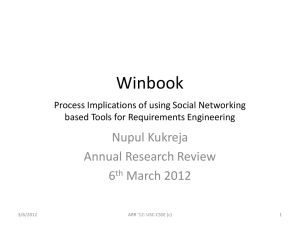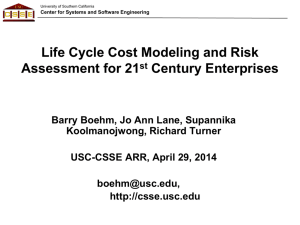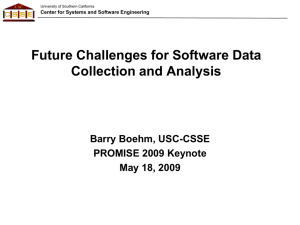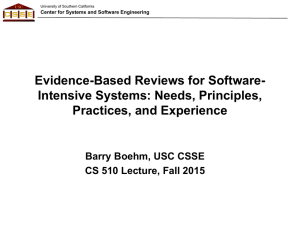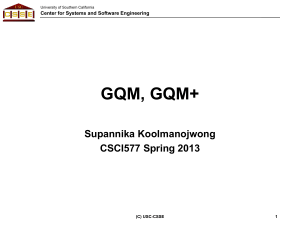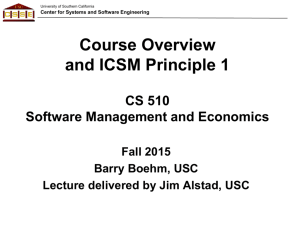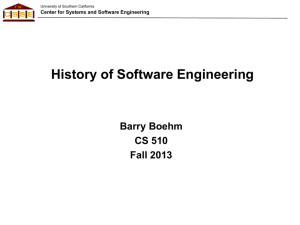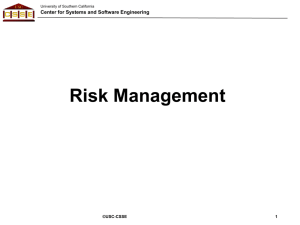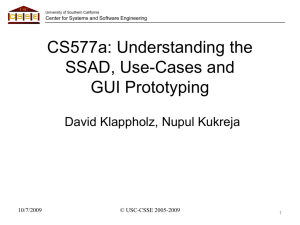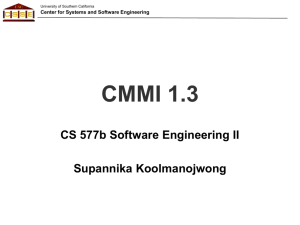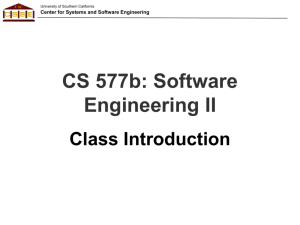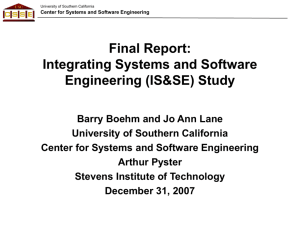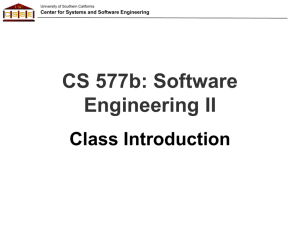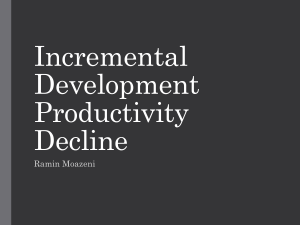Course Overview CS 510 Software Management and Economics
advertisement
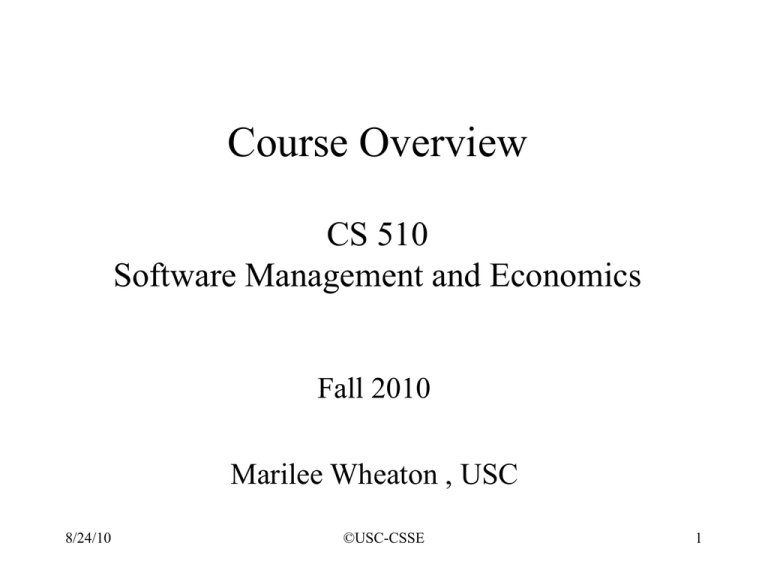
Course Overview CS 510 Software Management and Economics Fall 2010 Marilee Wheaton , USC 8/24/10 ©USC-CSSE 1 Outline • Course objective – Help you learn to be a successful software manager – For a career lasting through the 2040’s. • Software management learning objectives – What does a successful SW manager need to deal with? • What does a successful (software) manager need to do? – Enterprise Success Theorem – Enterprise Success Realization Theorem • Overview of VBSE Theory – Value-Based Software Engineering • Overview of Course – Programmatics, schedule, academic integrity • ICM Overview • This Week’s Assignment 8/24/10 ©USC-CSSE 2 What Does A Successful Software Manager Need to Deal With? 8/24/10 ©USC-CSSE 3 What Do SW Managers Need to Deal With? • People: customers, users, architects, designers, programmers, testers, lawyers, venture capitalists, suppliers, politicians, … • Products: requirements, designs, code, documentation, plans, tools, data, facilities, equipment, … • Projects: proposals, presentations, contracts, deliverables, budgets, schedules, milestones, … • Resources: time, money, space, communications, skills, … • Technology: software, hardware, domain technology, COTS, OSS, … • Organizations and Cultures: top management, marketing, sales, development, finance, customer/user organizations, … • Changes in all of the above 8/24/10 ©USC-CSSE 4 What Does A Successful Software Manager Need to Do? 8/24/10 ©USC-CSSE 5 Software Management Guidelines • Eclectic combinations of advice • Management frameworks • Maturity models • People management theories: X, Y, Z • Enterprise Success Theorem: Theory W • Enterprise Success Realization Theorem 8/24/10 ©USC-CSSE 6 Sorting out software advice Prove everything correct Automated aids Do it outside-in Use walk-throughs Programming standards Measurable milestones Involve the user Structured Programming End-item acceptance plan Unit development folders 8/24/10 ©USC-CSSE 7 Koontz-O’Donnell Management Framework Planning Organizing — Purpose — Purpose – Unity of goals – Contribution to goals – Commitment – Verifiability – Cost-Effectiveness – Precedence – Costeffectiveness – Span of Management — Delegation of Authority — Structure – Premises – WWWWWHHW – Synchronization — Process – Limiting Factor – Unity of command – Parity of authority •Responsibility – Authority level – Absoluteness of responsibility — Division of Work – Form follows function – Flexibility • People’s strengths – Navigational change – Functional definition – Performer – Separation Participation 8/24/10 Staffing — Purpose – Contribution to Directing Controlling — Purpose – Harmony of goals goals — Selection – Top talent – Job matching – Career progression – Skills balance – Teamwork — Motivation – Understanding of goals – Reflection of goals — Purpose – Assurance of goals – Cost-effectiveness – Control responsibility — Structure – Reflection of plans – Organizational — Communication suitability – Parity of information – individuality •Responsibility — Recruiting – Reward – Openness – Commitment —Retention – Reinforcement – Team building – Phase out – Backup ©USC-CSSE – Receptiveness – Integrity — Leadership – Identification – Empathy – Sustained initiative – Integrity – Team building – Management of time — Process – Standards – Critical-point – Exception – Flexibility – Timeliness – Action 8 CMMI Process Areas Staged Representation Level 5 Optimizing Causal Analysis and Resolution Organizational Innovation & Deployment Level 4 Quantitative Project Management Quantitatively Managed Organizational Process Performance Organizational Process Focus Organizational Process Definition Organizational Training Level 3 Integrated Project Management Defined Risk Management Decision Analysis and Resolution Requirements Development Technical Solution • Integrated Teaming Product Integration • Organizational Environment Verification for Integration Validation Level 2 Managed Level 1 Performed 8/24/10 Project Planning Project Monitoring and Control Configuration Management Process & Product Quality Assurance Supplier Agreement Management Measurement and Analysis Requirements Management ©USC-CSSE 9 Theory X and Theory Y* • Theory X – People inherently dislike work – They have to be coerced into working – They prefer being told what to do • Theory Y – – – – – – People don’t inherently dislike work People can exercise self-direction Commitment to objectives depends on resulting rewards People can learn to seek responsibility Work creativity is widely distributed People’s potential is only partially utilized * D. McGregor, The Human Side of Enterprise, 1960. 8/24/10 ©USC-CSSE 10 Theory Z: Japanese-Style Management • People work best toward goals which they have helped establish • Once people have bought into goals, you can trust them to perform • If people share a common set of values, they can develop workable project goals 8/24/10 ©USC-CSSE 11 Theory W: Enterprise Success Theorem – And informal proof Theorem: Your enterprise will succeed if and only if it makes winners of your success-critical stakeholders • Proof of “if”: Everyone that counts is a winner. Nobody significant is left to complain. • Proof of “only if”: Nobody wants to lose. Prospective losers will refuse to participate, or will counterattack. The usual result is lose-lose. 8/24/10 ©USC-CSSE 12 Win-lose Generally Becomes Lose-lose Proposed Solution “Winner” Loser Quick, Cheap, Sloppy Product Developer & Customer User Lots of “bells and whistles” Developer & User Customer Driving too hard a bargain Customer & User Developer Actually, nobody wins in these situations 8/24/10 ©USC-CSSE 13 Enterprise Success Realization Theorem Theorem: Your enterprise can realize success if and only if 1. You identify and involve all of the success critical stakeholders (SCSHs) – 2. Dependency theory You determine how the SCSHs want to win – 3. Utility theory You help the SCSHs determine and commit to a win-win course of action and solution – 4. Decision theory You adaptively control the course of action to continue to realize a win-win solution – 8/24/10 Control theory ©USC-CSSE 14 VBSE Theory 4+1 Structure Dependency Theory How do dependencies affect value realization? Utility Theory What values are important? How is success assured? How important are the values? Theory W: SCS Win-Win How to adapt to change and control value realization? How do values determine decision choices? Control Theory 8/24/10 Decision Theory ©USC-CSSE 15 VBSE Component Theories • Theory W (Stakeholder win-win) – Enterprise Success Theorem, Win-Win Achievement Theorem • Dependency Theory (Product, process, people interdependencies) – Systems architecture/performance theory, costing and scheduling theory; organization theory • Utility Theory – Utility functions, bounded rationality, Maslow need hierarchy, multi-attribute utility theory • Decision Theory – Statistical decision theory, game theory, negotiation theory, theory of Justice • Control Theory – Observability, predictability, controllability, stability theory 8/24/10 ©USC-CSSE 16 Initial VBSE Theory: 4+1 Process – With a great deal of concurrency and backtracking 5a, 7b. Option, solution development & analysis Dependency Theory Utility Theory 2a. Results Chains 2. Identify SCSs 3b, 5a, 7b. Cost/schedule/ performance tradeoffs 3b, 7a. Solution Analysis 3. SCS Value Propositions (Win conditions) 4. SCS expectations management Theory W: SCS Win-Win 6, 7c. Refine, Execute, Monitor & Control Plans Control Theory 5. SCS Win-Win Negotiation 1. Protagonist goals 3a. Solution exploration 7. Risk, opportunity, change Decision Theory management 6a, 7c. State measurement, prediction, correction; Milestone synchronization 8/24/10 5a, 7b. Prototyping 5a. Investment analysis, Risk analysis ©USC-CSSE SCS: Success-Critical Stakeholder 17 Outline • Course objective – Help you learn to be a successful software manager – For a career lasting through the 2040’s. • Software management learning objectives – What does a successful SW manager need to deal with? • What does a successful (software) manager need to do? – Enterprise Success Theorem – Enterprise Success Realization Theorem • Overview of VBSE Theory – Value-Based Software Engineering • Overview of Course – Programmatics, schedule, academic integrity • ICM Overview • This Week’s Assignment 8/24/10 ©USC-CSSE 18 Comparison of CS 510 and CS 577a CS 510 CS 577a • VBSE Theory, Practice • COCOMO II Extensions • VBSE Framework • Microeconomics • ICM – Decision Theory • WinWin Spiral • Agile and Rapid – Risk Management Development •Planning & Control – COCOMO II • People Management • Business Case • 2 Midterms, Final Analysis 8/24/10 ©USC-CSSE • S/W - System Architecting • Operational Concept & Rqts. Definition – WinWin System – Prototyping • OO Analysis & Design – Rational Rose •Team Project (DEN: IV&V) 19 CS 510 Course Schedule Overview • Aug 24 – Sep 28 VBSE, ICM, Agility and Discipline, People Management, COCOMO II • Sep 28 Midterm Exam I • Oct 5 – Oct 26 Software Microeconomics, Risk and Business Case Analysis • Oct 26 Midterm Exam II • Nov 2 – Nov 30 COTS Integration, Planning & Control, Maturity Models, Case Studies • Dec 7 Final Exam 8/24/10 ©USC-CSSE 20 CS 510 Programmatics - I Basis of grade. Final Exam, 30%; 2 midterms: 20%; Homework exercises: 50%. Texts. Boehm et al., Software Cost Estimation with COCOMO II, Prentice Hall, 2000; Selby, Software Engineering: Barry W. Boehm’s Lifetime Contributions to Software Development, Management and Research, Wiley, 2007; Boehm and Turner, Balancing Agility and Discipline, Addison and Wesley, 2004 Instructors. Prof. Marilee Wheaton, SAL 328, (213) 740-8163, Fax (213) 740-4927; Office Hours. Marilee: Tuesday, 5:30-6:30 PM or by appointment. SAL 328. Teaching Assistants. Tom Tan, Vu Nguyen, Qi Li TA Office Hours. Please check it online Web page: http://sunset.usc.edu/classes/cs510_2010/index.html 8/24/10 ©USC-CSSE 21 CS 510 Questionnaire and Acknowledgement Please fill out and return. Name: _________________________________________________ Student ID #: ___________________________________________ Dept./Degree Program: __________________________________ Job, Employer: _________________________________________ Software Work Experience (years): _______________________ Phone, fax numbers: ____________________________________ E-mail Address: ________________________________________ Acknowledgement: I acknowledge the importance of USC's academic integrity standards (with respect to plagiarism, referencing others' work, etc.), and agree to abide by them. Signature: ______________________________________________ 8/24/10 ©USC-CSSE 22 Academic Integrity Acknowledgement • Single most-serious offense: Plagiarism – Using other people’s work without crediting them – Homework, exams, class exercises, individual assignments • Minor first offense: You lose one grade level – E.g., B+ instead of A- • Major first offense or second offense: F for the course 8/24/10 ©USC-CSSE 23 We are Serious About Plagiarism – And experienced in finding it ID 32 8 46 39 30 36 44 42 35 23 8/24/10 Critique Individual Total Team Total 182 453.25 715.4 160 454 708.875 185 450 708.875 182 430.55 715.4 140 428.5 708.875 186 461.75 674.4 0 136 674.4 165 456.875 674.4 190 452.08 674.4 185 433.25 674.4 ©USC-CSSE Total Final Grade 1168.65 B+ 1162.875 B+ 1158.875 B+ 1145.95 B+ 1137.375 B+ 1136.15 B+ 810.4 F 1131.275 B+ 1126.48 B+ 1107.65 B 24 Outline • Course objective – Help you learn to be a successful software manager – For a career lasting through the 2040’s. • Software management learning objectives – What does a successful SW manager need to deal with? • What does a successful (software) manager need to do? – Enterprise Success Theorem – Enterprise Success Realization Theorem • Overview of VBSE Theory – Value-Based Software Engineering • Overview of Course – Programmatics, schedule, academic integrity • ICM Overview • This Week’s Assignment 8/24/10 ©USC-CSSE 25 The Incremental Commitment Life Cycle Process: Overview Stage I: Definition Stage II: Development and Operations Anchor Point Milestones Synchronize, stabilize concurrency via FEDs Risk patterns determine life cycle process 8/24/10 ©USC-CSSE 15 July 2008 ©USC-CSSE 26 26 Anchor Point Feasibility Evidence Description • Evidence provided by developer and validated by independent experts that: If the system is built to the specified architecture, it will – Satisfy the requirements: capability, interfaces, level of service, and evolution – Support the operational concept – Be buildable within the budgets and schedules in the plan – Generate a viable return on investment – Generate satisfactory outcomes for all of the successcritical stakeholders • All major risks resolved or covered by risk management plans • Serves as basis for stakeholders’ commitment to proceed Can be used to strengthen current schedule- or event-based reviews 8/24/10 ©USC-CSSE 27 Process Model Principles Principles trump diagrams 1. Commitment and accountability - Needed for high assurance systems 2. Success-critical stakeholder satisficing - Needed for multi-owner systems of systems 3. Incremental growth of system definition and stakeholder commitment - Needed for emergent requirements, rapid change 4, 5. Concurrent, iterative system definition and development cycles - Needed for rapid change, rapid OODA loops 6. Risk-based activity levels and anchor point commitment milestones Used by 60-80% of CrossTalk Top-5 projects, 2002-2005 8/24/10 ©USC-CSSE 28 Incremental Commitment in Gambling • Total Commitment: Roulette – Put your chips on a number • E.g., a value of a key performance parameter – Wait and see if you win or lose • Incremental Commitment: Poker, Blackjack – Put some chips in – See your cards, some of others’ cards – Decide whether, how much to commit to proceed 8/24/10 ©USC-CSSE 29 Scalable remotely controlled operations 8/24/10 ©USC-CSSE 30 Total vs. Incremental Commitment – 4:1 RPV • Total Commitment – Agent technology demo and PR: Can do 4:1 for $1B – Winning bidder: $800M; PDR in 120 days; 4:1 capability in 40 months – PDR: many outstanding risks, undefined interfaces – $800M, 40 months: “halfway” through integration and test – 1:1 IOC after $3B, 80 months • Incremental Commitment [number of competing teams] – $25M, 6 mo. to VCR [4]: may beat 1:2 with agent technology, but not 4:1 – $75M, 8 mo. to ACR [3]: agent technology may do 1:1; some risks – $225M, 10 mo. to DCR [2]: validated architecture, high-risk elements – $675M, 18 mo. to IOC [1]: viable 1:1 capability – 1:1 IOC after $1B, 42 months 8/24/10 ©USC-CSSE 31 First Week’s Assignments Homework 1 • Today: Sign and turn in questionnaire and acknowledgement • By Tuesday, August 31, 2010, 12 Noon: Read SMB-0 Case Study (EP-1), ICM Papers (EP2, EP-3), VBSE Theory (BB 9-5) • Identify, turn in bulleted lists of shortfalls with respect to the ICM principles of key stakeholder satisficing, incremental commitment, and evidence-based project reviews 8/24/10 ©USC-CSSE 32 Example Project: Sierra Mountain bikes • Based on what would have worked on a similar project • Quality leader in specialty area • Competitively priced • Major problems with order processing – Delivery delays and mistakes – Poor synchronization of order entry, confirmation, fulfillment – Disorganized responses to problem situations – Excess costs; low distributor satisfaction 8/24/10 ©USC-CSSE 33
